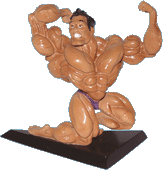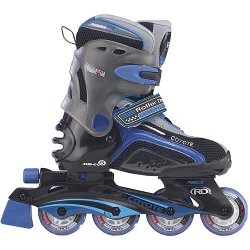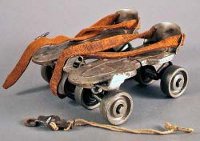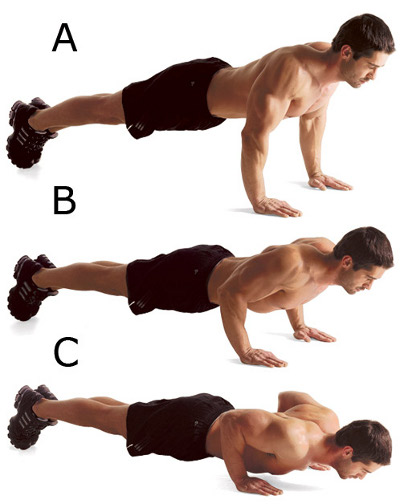Categories: "Sports & Fitness"
Отжимания от пола (отжиматься)
I'm convinced that everyone who reads this blog is not only an intellectual, but also a person committed to personal fitness and the betterment of the planetary environment, personal moral wisdom, and social justice. So of course all my readers want to know the word for push-ups in Russian. In addition to a noun, the Russians use use the verb отжиматься, which literally means “to press away from.” Verbs can often be turned into nouns by subtracting the -ть and adding -ние. Thus “pressings away from the floor” (push-ups) can be turned into the neuter plural отжимания от пола. Here are examples:
| Каждый день я пятьдесят раз отжимаюсь. | Every day I do fifty push-ups |
| Каждый день я делаю 50 отжиманий. | Every day I do fifty push-ups |
Here's a nice description of how to perform a standard push-up:
| Отжимания от пола | Push-ups |
| Техника выполнения | Technique |
| Ноги слегка расставлены, руки на ширине плеч. Не прогибайтесь в спине, корпус должен составлять одну диагональную прямую. Медленно опуститесь к полу. Если руки прижать к туловищу, нагрузка ляжет на трицепсы. Если локти расположить перпендикулярно к телу, также задействуются грудные мышцы. (source) | Legs are placed slightly apart. Hands are at shoulder-width. Don't flex the back. The body should make a single diagonal line. Slowly lower towards the floor. If you press the arms against the trunk, the load falls on the triceps. If you set the elbows perpendicular to the body, chest muscles will also be activated. |
Total fitness freaks might like this advice:
| Советую делать отжимание в стойке на руках, можно возле стенки. Нужно, чтобы голова коснулась пола, чудесное упражнения для многих мышц, как грудь, спина, трицепс! (source) | I suggest doing push-ups from hand-stand. You can do it next to a wall. The head should touch the floor. It's an excellent exercise for many muscles and the chest, back, and triceps. |
Here's a work-out with one-armed push-ups:
| Я отжимаюсь через день по утрам 30 минут, 4 подхода по 30 раз на кулаках, ноги на стуле, 5,6 подходов на одной руке по 10 раз. После тренировки очень потею, отдышка хорошая. (adapted from this source) |
Every other day for 30 minutes I do 4 sets of 30 on my fists with my feet on a chair, and then five or six sets of ten on one arm. After the work-out I sweat likе crazy, and my breath is normal. |
Just like Americans, young Russian men have to do a lot of push-ups in the army where they will hear:
| Двадцать отжиманий! Быстро! | Twenty push-ups! Quickly! |
One push-up phrase that has become very popular since the nineties is taken from the lips of the General Lebedev puppet on the popular Russian political puppet show «Куклы». Lebedev is quoted often as saying:
| Упал-oтжался! | Down for push-ups! |
Notice the interesting use of the past tense here as a type of command form. That is the strongest form of command possible in Russian; it essentially indicates a complete lack of compassion or respect for the addressee. Don't ever use it in Russia unless you yourself join the Russian army and are hazing recruits to the point of suicide.
Качок
Качок is gym slang for a guy who is trying to put on a ton of muscle:
| Как правило качками называют бодибилдеров. | As a rule body-builders are called “качки.” |
For a neat reference of body-building terminology and gym slang, see this forum.

Стойка на голове
The Russian phrase for а hеаdstand is стойка на голове. Examples:
| Каждое утро я по десять минут делаю стойку на голове. | Every morning I do headstand for ten minutes. |
| Мой друг уже около двадцати лет выполняет стойку на голове. | My friend has been doing headstand for twenty years now. |
| Каждое утро я десять минут стою на голове. | Every morning I stand on my head for ten minutes. |
| Вчера я делал стойку на голове, и брат толкнул меня. Теперь болит шея. | Yesterday I was doing a headstand and my brother knocked me over. Now my neck hurts. |
| Если вы боитесь удариться об пол спиной - делайте стойку на голове у стены. | If you are afraid of falling on your back, do headstand at the wall. |
Headstand can be a bit scary if you don't have some good instructions. Here's a set I adapted from the personal website of a Russian businessman-yogi
| Опустись на колени, сплети пальцы рук в замок. | Get down on your knees and weave your fingers together into a locked position. |
| Расположи кисти и предплечья на полу перед коленями для создания опоры. | Place your wrists and forearms on the floor in front of your knees for support. |
| Положи голову макушкой на пол, обхвати ее замком ладоней сзади. | Place the top of your head on the floor and grasp it from behind with your locked fingers. |
| Оторви колени от пола, плавно поднимая таз вверх. | Take your knees of the floor, smoothly raising the pelvis upwards. |
| Медленно перенеси вес тела с пальцев ног на голову и руки. | Slowly transfer your bodyweight from the toes to the head and arms. |
| Плавно подними над полом обе стопы одновременно. | Smoothly raise both feet above the floor simultaneously. |
| Сначала плавно переведи в вертикальное положение туловище с поджатыми ногами, затем бедра и, в заключение, голени ног. | First bring the torso into a vertical position with your legs bent, then [do the same with] the thighs and, finally, the shins. |
| Вытяни ноги к верху и стой на голове так, чтобы все тело было перпендикулярно полу. | Stretch your legs upward and remain on your head so that your whole body is perpendicular to the floor. |
Here's a video of some anonymous geekoid doing a headstand:
And here's a nice graphic of the stages:

Ролики

The Russian word for roller blades is ролики. A few months ago, my friend became very interested in learning how to rollerblade. She was determined to become good at rollerblading by the end of the month so that she could impress her boyfriend who was coming into town. She called me and said «Я хочу научиться кататься на роликах. Ты можешь помочь мне научиться?» “I want to learn to rollerblade. Can you help me learn?” I wanted to support my friend so I agreed and we went to Kiwanis Park that afternoon. I told her to be careful but she insured me that it was not a big deal and that rollerblading was “easy.”
I watched nervously as she began rollerblading on the sidewalk. She was doing very well and my nervousness finally began to ease. Unexpectedly, she turned towards me and said «Я хочу съехать с этой горы» “I want to ride down this hill.” Before I had time to answer, she was off, and I again watched nervously as she began her ride down the hill. I noticed that she was rollerblading down the hill very fast and with a terrified look on her face she yelled «Я не могу остановиться! Как мне остановиться?» “I can’t stop! How can I stop?” I watched in horror as she fell on the concrete. Luckily for my friend, she was wearing protective gear so her injuries were very minor. Now, she pays more attention when I tell her to be more careful.

Don's additional comments: A slightly more formal way to say the same thing is «роликовые коньки» “roller skates” as opposed to «ледовые коньки» “ice skates.” Ролики and роликовые коньки can mean both in-line skates and the old fashion skates with a "four corners" wheel arrangement.
